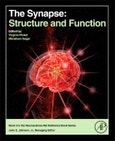The Synapse summarizes recent advances in cellular and molecular mechanisms of synaptic transmission and provides new insights into neuronal plasticity and the cellular basis of neurological diseases.
- Part 1 provides an in-depth look at structural differences and distribution of various pre- and post-synaptic proteins found at glutamatergic synapses.
- Part 2 is dedicated to dendritic spines and their associated perisynaptic glia, which together constitute the tripartite synapse. The spines are portrayed as major sites for calcium sequestration and local protein synthesis.
- Part 3 highlights the important regional and cellular differences between glutamatergic transmission and that of neurotransmitters such as dopamine and acetylcholine that are commonly found in axon terminals without synaptic membrane specializations.
- Part 4 provides an overview of the synapse from the time of formation to degeneration under the powerful influence of aging or hormonal decline that leads to severe deficits in cognitive function.
Each chapter is illustrated with drawings and images derived from calcium imaging, electron microscopic immunolabeling, or electrophysiology. This book is a valuable reference for neuroscientists and clinical neurologists in both research and clinical settings.
Please Note: This is an On Demand product, delivery may take up to 11 working days after payment has been received.
Table of Contents
Chapter 1: Structure and Complexity of the Synapse and Dendritic Spine Stewart
Chapter 2: The Molecular Mechanisms Underlying Synaptic Transmission: A View of the Presynaptic Terminal Ashery
Chapter 3: The First Hour in the Life of a Synapse: Contact Formation, Partner Selection and Onset of Function Cheyne
Chapter 4: Structural and Functional Organization of the Postsynaptic Density Verpelli
Chapter 5: The Tripartite Synapse: A Role for Glial Cells in Modulating Synaptic Transmission Blutstein
Chapter 6: Local Protein Synthesis at Synapses Steward
Chapter 7: Estrogen Effects on Hippocampal Synapses Milner
Chapter 8: Trafficking of Glutamate Receptors and Associated Proteins in Synaptic Plasticity Horak
Chapter 9: Structural Alterations of Synapses in Psychiatric and Neurodegenerative Disorders Penzes
Chapter 10: Synaptic Correlates of Aging and Cognitive Decline Hara
Chapter 11: Activity-Induced Fine Structural Changes of Synapses in the Mammalian Central Nervous System Tao-Cheng
Chapter 12: Activity-mediated Structural Plasticity of Dendritic Spines Muller
Chapter 13: Experience-dependent Synaptic Plasticity in the Developing Cerebral Cortex Aoki
Chapter 14: Asynaptic and Synaptic Innervation by Acetylcholine Neurons of the Central Nervous System Descarries
Chapter 15: Prefrontal Cortical Dopamine Transmission: Ultrastructural Studies and Their Functional Implications Sesak








